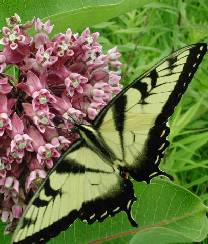

ABSTRACT:Students will investigate questions related to the pollination ecology of the most common and accessible insect-pollinated
flowers in bloom. Students will start with natural history observations to answer common questions such as how long does the flower stay open,
what are its major visitors, and how often is it visited by likely pollinators. They may then follow up the class study with their own questions,
such as whether flowers that are in large clumps are more likely to be visited than more isolated flowers, how far the most frequent visitors fly
between visits, how likely is it that the next visit will be to the same species of flower, and whether self pollen grows through the style more
slowly than pollen from a different individual. Common techniques in pollination studies such as determination of flowering phenology, visitation
rates, and identification of visitors and of pollen carried on visitors will be used regardless of the question to be investigated. Spring beauties
in the campus lawn, buckeye or crabapple flowers, horticultural plantings on campus, roadside goldenrods, or wildflowers in nearby natural
areas should make it possible to complete this lab at almost any time in the growing season. AUTHOR:
Biology Department, Millikin University,
1184 West Main, Decatur, IL 62522 ___________________________________________ CLASS TIME:Two hours, plus travel time if necessary, for the initial observations. An additional hour of planning and approval of projects
to address student generated questions. At least one hour of lecture to precede the introduction of the lab. OUTSIDE OF CLASS TIME:Pre-lab questions, one hour, two to four hours for the data collection for the class project, and two to four more hours to complete
the projects from student generated questions. Flowering phenology questions require multiple short (ten minute) visits to the study site over the
period the flowers are open, from one day for most composite flowers up to a week for flowers such as spring beauties. STUDENT PRODUCTS:
SETTING:Outdoors, using easily accessible plants such as spring beauties in the campus lawn, buckeyes or crabapples on
campus, roadside goldenrods, or wildflowers in nearby natural areas. Landscape plantings on campus can also be used. Some lab/microscope
work also necessary, as well as access to computers with graphics software. COURSE CONTEXT:
This lab activity is used in four different courses at Millikin University: (1) non-majors course, Local Flora, with 18 students,
(2) freshman biology major’s course, Attributes of Life, with five lab sections of 16 students each,
(3) upper division summer Field Ecology course for 10-12 non-majors, and
(4) upper division Plant Biology course for 12-16 junior and senior undergraduate students. Details of how the activity is used in each of these courses
appear in the "Notes to Faculty: Uses of this Lab Activity in Different Courses at Millikin University" below.
INSTITUTION:Private, four-year, smaller comprehensive university TRANSFERABILITY:Useful for non-majors in local flora and field ecology immersion classes, as well as junior and senior biology majors in upper
level Plant Biology. Also adaptable for younger students, with more emphasis on observations. Additional comments appear in the
"Notes to Faculty: Translating the Activity to Other Institutional Scales." ACKNOWLEDGMENTS:
The major part of the idea for this lab activity was inspired by a workshop at the ESA meetings in Albuquerque, New Mexico by
Alan Berkowitz and Kathleen Hogan, 1997 on Schoolyard Ecology for Elementary School Teachers (SYEFEST), and by Peter Feinsinger’s
work with Berkowitz, Margutti, Grajal, and Oviedo. Much of the design of the activity was done as a module that was a part of a National
Science Foundation grant (DUE #9653676) to Millikin University, “Creating Linkages Through Institution Wide Reform of the Science Curriculum.”
Dean Mauri Ditzler and Clarence Josephson, of the Millikin Chemistry Department, and Marianne Robertson of Biology, encouraged the
development of the module. This submission has benefited from comments by TIEE Editors and an anonymous reviewer. CITATION:Parrish, J. July 2004, posting date. Pollination Ecology: Field Studies of Insect Visitation and Pollen Transfer Rates. Teaching Issues and Experiments in Ecology, Vol. 2: Experiment #3 [online]. http://tiee.ecoed.net/vol/v2/experiments/pollinate/abstract.html |

Tiger Swallowtail (Papilio glacus) visiting Milkweed (Ascelpias), © Judy Parrish,
full size image
|
<top> | |